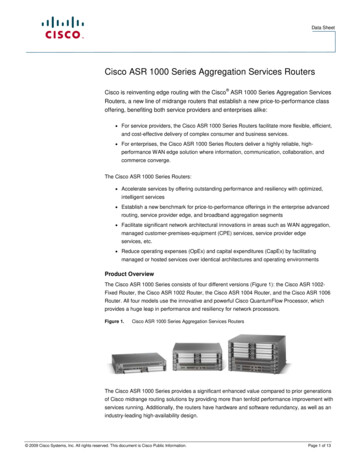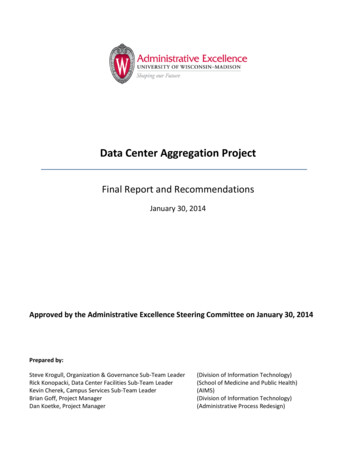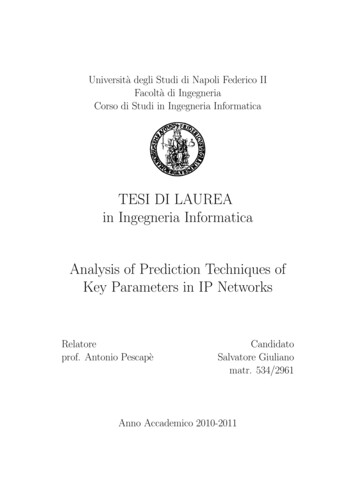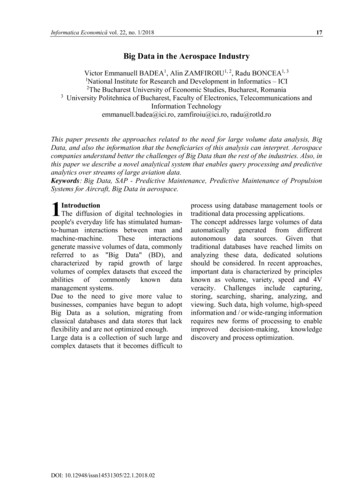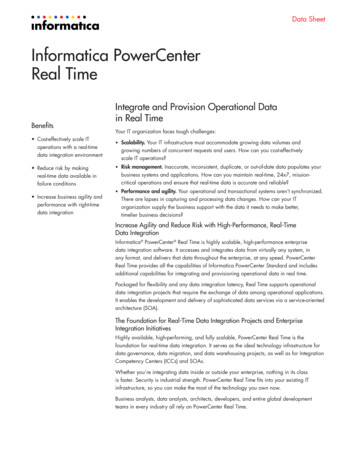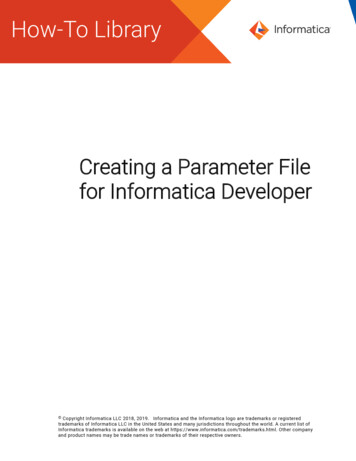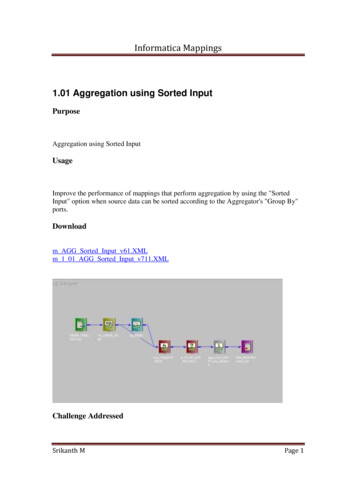
Transcription
Informatica Mappings1.01 Aggregation using Sorted InputPurposeAggregation using Sorted InputUsageImprove the performance of mappings that perform aggregation by using the "SortedInput" option when source data can be sorted according to the Aggregator's "Group By"ports.Downloadm AGG Sorted Input v61.XMLm 1 01 AGG Sorted Input v711.XMLChallenge AddressedSrikanth MPage 1
Informatica MappingsIn a typical PowerCenter mapping that performs aggregation (without the Sorted Inputoption), the Informatica server must read the entire data source before it beginsperforming calculations, in order to ensure that it has received every record that belongsto each unique group. While the server is optimized to perform aggregate calculations,the time required to read the entire data source can be a bottleneck in mappings that loadvery large amounts of data.OverviewIn a mapping that uses Sorted Input, the Informatica server assumes that all data enteringan Aggregator transformation are already sorted into groups that correspond to theAggregator’s "Group By" ports. As a result, the server does not have to read the entiredata source before performing calculations. As soon as the Aggregator detects a newunique group, it performs all of the calculations required for the current group, and thenpasses the current group’s record on to the next transformation. Selecting Sorted Inputoften provides dramatic increases in Aggregator performance.Implementation GuidelinesIn order for Sorted Input to work, you must be able to sort the data in your source by theAggregator’s Group By columns.The key concepts illustrated in this mapping template can be found in two transformation objects,the Source Qualifer transformation (SQ ORDER ITEMS) and the Aggregator transformation(agg CALC PROFIT and MARGIN):SQ ORDER ITEMS contains a SQL Override statement that pulls data from theORDER ITEMS table. The select statement in this SQL Override contains an ORDERBY clause that orders the source data by the ITEM ID column. In addition, on theProperties tab of SQ ORDER ITEMS, the "Number of Sorted Ports" option is set to "1."Configuring the Source Qualifier in this way prepares the data for Sorted Inputaggregation.In agg CALC PROFIT and MARGIN, the ITEM ID port is selected as the "Group By"port in the transformation (the number of "Group By" ports must correspond to the"Number of Sorted Ports" indicated in the Source Qualifier object). In addition, on theProperties tab of agg CALC PROFIT and MARGIN, the "Sorted Input" option isselected.Srikanth MPage 2
Informatica MappingsNo other configuration is required in order for Sorted Input functionality to work in this mapping.When a session is created to implement this mapping, it will automatically detect that the SortedInput option has been selected.Please refer to the metadata descriptions in the mapping m AGG Sorted Input for more detailson the functionality provided by this mapping template.Pros Improves performance of mappings that perform aggregation. Can be used with relational and file-based sources, as long as data can be sortedaccording to the Aggregator’s "Group By" ports.Cons With relational sources, additional overhead is exerted on the database when "Order By"clauses are used.1.03 Constraint-Based LoadingPurposeConstraint-based load orderingUsageUsing one mapping and session, load two tables that have a parent / child (primary key /foreign key) relationship.Downloadm Constraint Based Loading v61.XMLm 1 03 Constraint Based Loading v711.XMLSrikanth MPage 3
Informatica MappingsChallenge AddressedTables in the same dimension are frequently linked by a primary key / foreign keyrelationship, which requires that a record exist in the "parent" table before a relatedrecord can exist in a "child" table. Often these tables are populated by the same datasource. One method of populating parent / child tables is to set up a separate mapping andsession for each one. However, that requires two reads of the source. This mappingtemplate illustrates PowerMart/ PowerCenter’s "Constraint Based Load Ordering"functionality, which allows developers to read the source once and populate parent andchild tables in a single process.OverviewIn a mapping that uses Constraint Based Load Ordering, the Informatica server orders thetarget load on a row-by-row basis. For every row generated by an active source, theInformatica Server loads the corresponding transformed row first to the primary key table(the "parent" table), then to any foreign key tables (the "child" tables). An active source isthe last active transformation in a data stream pipeline. The following transformationscan be an active source within a mapping: Source QualifierNormalizer (COBOL or flat file)Advanced External ProcedureAggregatorSrikanth MPage 4
Informatica Mappings JoinerRankFilterRouterMapplet, if it contains one of the above transformationsImplementation GuidelinesConstraint-based load ordering is only implemented in a session for target tables thatreceive rows from the same active source. When target tables receive records fromdifferent active sources, the Informatica Server reverts to normal loading for those tables.For example, a mapping contains three distinct data streams: the first two both contain asource, Source Qualifier, and target. Since these two targets receive data from differentactive sources, the Informatica Server reverts to normal loading for both targets. Thethird data stream contains a source, Normalizer, and two targets. Since these two targetsshare a single active source (the Normalizer), the Informatica Server performs constraintbased load ordering: loading the primary key table first, then the foreign key table.When target tables have no key relationships, the Informatica Server does not performconstraint-based loading. Similarly, when target tables have circular key relationships,the Informatica Server reverts to a normal load. For example, you have one targetcontaining a primary key and a foreign key related to the primary key in a second target.The second target also contains a foreign key that references the primary key in the firsttarget. The Informatica Server cannot enforce constraint-based loading for these tables. Itreverts to a normal load.The key concepts illustrated in this mapping template can be found in the Routertransformation (RTR NEW MANUFACTURERS ALL ITEMS) and the two targetobjects ITEMS and Manufacturers.RTR NEW MANUFACTURERS ALL ITEMS is the last single active source ofdata for the two targets. The targets ITEMS and Manufacturers have a Primary Key –Foreign Key relationship. A manufacturer ID must exist in the Manufacturers tablebefore a row containing the manufacturer ID, can be loaded into the ITEMS table.Using a normal load for this mapping would result in a constraint error, as thePowerCenter server would attempt to load the tables in any order. In this example, thismay result in attempt to load a row into the ITEMS table that does not have acorresponding manufacturer in the Manufacturers tableSrikanth MPage 5
Informatica MappingsUse constraint-based load ordering only when the session option Treat Rows As is set to"Insert." When you select a different Treat Rows As option and you configure the sessionfor constraint-based loading, the Server Manager displays a warning. A session can beconfigured for constraint-based load ordering by selecting the "Constraint-based loadordering" check box on the Configuration Parameter window of the Session Propertiessheet. The Configuration Parameter window is accessed by selecting the button"Advanced Options" from the General Tab of the session properties window.1.04 Loading Incremental UpdatesPurposeLoading Incremental ChangesUsageUses PowerMart / PowerCenter Mapping Variables to process incremental changes in atable only, rather than re-processing all of the data in the source table.Downloadm LOAD INCREMENTAL CHANGES v61.XMLm 1 04 LOAD INCREMENTAL CHANGES v711.XMLSrikanth MPage 6
Informatica MappingsChallenge AddressedWhen data in a source table is frequently updated, it is necessary to capture the updatedinformation in the data warehouse. However, due to data volumes and load windowconsiderations, it is often desirable to process only those records that have been updated,rather than re-reading the entire source into a mapping.OverviewThere are a few different methods of processing only the incremental changes that existin a source table. This mapping template illustrates a method of using a PowerMart /PowerCenter mapping variable to process only those records that have changed since thelast time the mapping was run.Implementation GuidelinesMapping variables add flexibility to mappings. Once a mapping variable has beendeclared for a mapping, it can be called by mapping logic at runtime. Unlike mappingparameters, the value of a mapping variable can change throughout the session. When asession begins, it takes the current value of the mapping variable from the repository andbrings it into the mapping. When the session ends, it saves the new value of the mappingvariable back to the repository, to be used the next time the session is implemented.The mapping in this template uses a mapping variable called INCREMENT TS. Thisvariable is used in two places within the mapping:In the Source Qualifier transformation SQ Customer Master, the mapping variable isincluded in the SQL Override;In the Expression transformation exp SET INCREMENT TS, the mapping variable isset by the port v SET INCREMENT TS.In this example, when the variable INCREMENT TS was declared, it was given aninitial value of "2000-01-01." So, the first time a session that implements this mappingruns, the value of INCREMENT TS will be "2000-01-01." At runtime, the Informaticaserver will translate the WHERE clause in the SQL Override statement from:Srikanth MPage 7
Informatica MappingsWHEREUPDATE TS ' INCREMENT TS'To:WHEREUPDATE TS '2000-01-01'Thus, the first time the mapping runs it will pull all records for which the "updatetimestamp" is greater than January 1, 2000.Also, note that the SQL Override queries the database for the value of SYSDATE, andpulls that value into the mapping through the CURRENT TIMESTAMP port. Thisbrings the current system date from the source system into the mapping. This value willbe used in the proceeding Expression transformation to set a new value for INCREMENT TS.The Expression transformation exp SET INCREMENT TS sets a new value for INCREMENT TS. To do this, it uses the SetVariable function to set the value of INCREMENT TS to the value stored in the port CURRENT TIMESTAMP , which isactually the value of SYSDATE from the source system. When the session implementingthis mapping completes, this new value for INCREMENT TS will be stored in therepository. As a result, the next time the mapping is run, only those records that have anUPDATE TS greater than the SYSDATE for the previous session’s run will beprocessed.Pros Process fewer records by eliminating static, unchanged records from the dataflow.Cons Relies on the existence of some kind of "update timestamp" in the source table.Srikanth MPage 8
Informatica Mappings1.05 Error Handling StrategyUsageUse this template as a guide for trapping errors in a mapping, sending errors to an errortable so that they can be corrected, and reloading fixed errors from the error table into thetarget system.Challenge AddressedSrikanth MPage 9
Informatica MappingsDevelopers routinely write mapping logic that filters records with data errors out of a datastream. However, capturing those error records so that they can be corrected and reloaded into a target system can present a challenge. The mappings in this mappingtemplate illustrate a process for trapping error records, assigning a severity level to eacherror, and sending the error rows – which include the complete source row plus additionalcolumns for the error description and severity level – on to an error table.OverviewThis mapping template provides two mappings that, taken together, illustrate a simpleapproach to utilizing Informatica objects in handling known types of Errors. The essentialobjects shown and utilized are Expression transformations that provide error evaluationcode, Lookup transformations that are used to compare or find prerequisite values, and aRouter transformation that sends valid rows to the warehouse and error rows to anappropriate error table.The key to the utilization of the error table in this example is to preserve the sourcerecord’s data structure for eventual correction and reprocessing. The first mapping thatruns is m Customer Load. Each source row that is flagged as an error is loaded into theerror table, along with an error description per row so that a subject matter expert canview, identify and correct errors. M Customer Fixed Error Load pulls fixed errorsfrom the error table and loads them into the target system.Implementation GuidelinesThe error handling in this mapping template is looking at the following known issueswith the source data: evaluating whether state and company columns are null or are of thecorrect length; ensuring email data is in a valid format; and validating that there aresupporting rows in the Company and State lookup tables. There is also an assignment ofseverity level that is used to deliver rows to either the Warehouse or the Error table orboth. Along with a severity level, an error description is assigned per error to assist in thecorrection process.The key concepts illustrated by these mappings can be found in three transformationobjects: a reusable Expression transformation (exp GENERAL ERROR CHECK),the Expression transformation (exp Customer Error Checks) and a Routertransformation (rtr NEW VALID ROWS and ERROR ROWS):Srikanth MPage 10
Informatica Mappingsexp GENERAL ERROR CHECK illustrates the concept that generic high level errorscan be checked universally so as not to maintain and/or update all obj
Download m_AGG_Sorted_Input_v61.XML m_1_01_AGG_Sorted_Input_v711.XML Challenge Addressed . Informatica Mappings Srikanth M Page 2 In a typical PowerCenter mapping that performs aggregation ( without the Sorted Input option), the Informatica server must read the entire data source before it begins performing calculations, in order to ensure that it has received every record that



